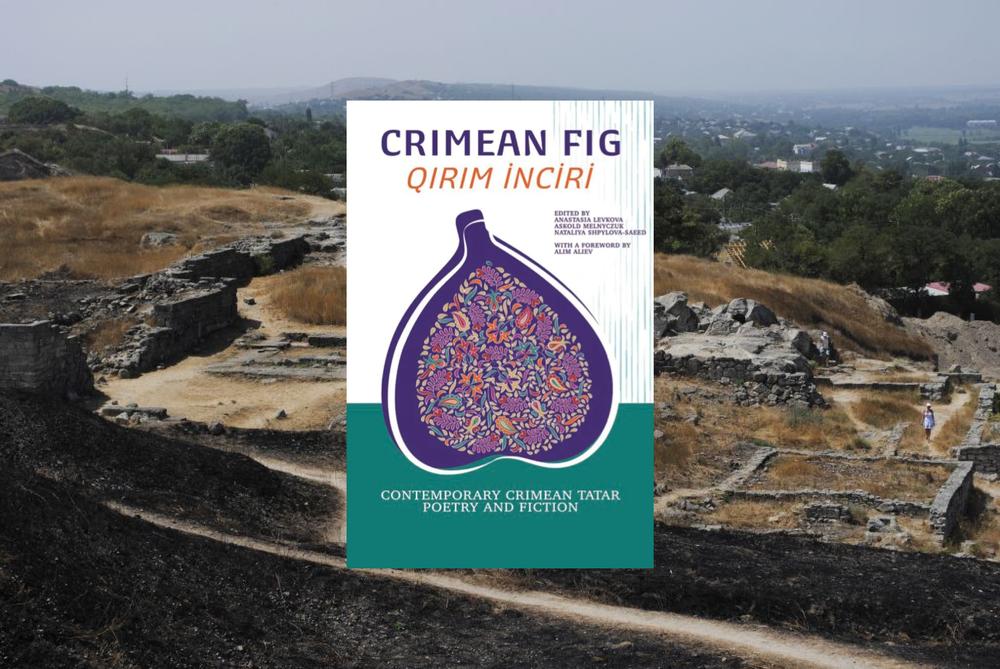To much of the world, Crimea is mostly synonymous with the start of Russia’s war against Ukraine — once a precious Black Sea resort, the peninsula was seized at gunpoint in 2014 and transformed into a fortified military outpost.
But behind the headlines of Russia’s ongoing occupation of Crimea is a deeper, often overlooked story: that of the Crimean Tatars, the indigenous people of the peninsula, who have endured centuries of repression and now face yet another struggle for survival under Russian rule.
The “Crimean Fig” anthology, published in English translation by Arrowsmith Press, brings together non-fiction, fiction, and poetry by Crimean Tatar authors, offering insight into their history, culture, resistance to Russian rule, and the quiet struggle to hold on to one’s identity and humanity in a land too often defined by who controls it, rather than who calls it home.
“Crimean Fig” began in Ukraine as an effort to promote Crimean Tatar literature and now counts four editions from Old Lion Publishing House, one of Ukraine’s most prestigious publishers. Its nonfiction, fiction, and poetry were chosen through an open competition for Crimean Tatar writers, including those still in Russian-occupied Crimea who could submit under pseudonyms.
The goal of first launching this cultural initiative in 2018, as Crimean Tatar activist and anthology co-editor Alim Aliev explains in the introduction, was not only to build closer ties between Crimean Tatar and Ukrainian literature, but also to serve as “an antidote to the Kremlin’s imperial efforts to forcibly integrate Crimea into the destructive ‘Russian world.’”
In his introduction, Aliev offers a concise history of Crimean Tatar literature, which dates back to the 13th century and flourished until the Russian Empire’s annexation of the peninsula in the 18th century, when the Russian language was imposed across all spheres of public and private life. A Crimean Tatar literary revival emerged in the late 19th century, mirroring the wider resurgence of national languages across the region during that time period.
Like Ukrainians, the Crimean Tatars suffered deeply under Soviet rule. Members of the Crimean Tatar intelligentsia were also arrested during the purges of the 1930s and, in trials that “lasted no more than twenty minutes each,” sentenced to death. In 1944, Soviet dictator Joseph Stalin ordered the mass deportation of nearly the entire Crimean Tatar population from the peninsula, with most of them sent to Uzbekistan. More than 46 percent died, and today it is recognized by Ukraine and multiple other countries as an act of genocide.
Crimean Tatar literature began to reemerge in the 1970s, with a focus on the pain of exile. After Ukraine gained independence in 1991 — and with it, Crimea — Crimean Tatars were finally able to return en masse and begin rebuilding their lives. That ended in 2014, when Russia returned to their shores.
Amid Russia’s full-scale war against Ukraine, contemporary Crimean Tatar literature increasingly grapples with the challenge of preserving one’s humanity within the dehumanizing confines of imprisonment. A distinct genre has even emerged — what some now call “literature behind bars.”
In “The Black Walls of the Zindan,” which is featured in the anthology, journalist Mustafa Amet offers a harrowing personal account of this struggle, detailing his abduction by Russian security services and the brutal torture that coerced a false confession of extremist activity.
Unfolding with raw emotional force, “The Black Walls of the Zindan” veers sharply between the harsh conditions of Amet’s imprisonment and the vivid, sometimes disjointed memories of the life stolen from him. Regret and shame course through the passages reckoning with his former self, who was once blind to suffering of the world around him. Alone in his cell, Amet finds that memory, fractured but insistent, offers but a fragile thread of maintaining one’s humanity.
“There are three essential elements to sanity. Pleasant memories show one the value of life and prove that it has not been wasted. Dreams of the future give one hope and strength to overcome obstacles; they inspire one to set goals and to continue to live. And finally, joy, which comes with food, safety, and creativity,” Amet writes.
“The evil executioners who put me into prison cannot take possession of my memories and dreams. In the midst of my heartbreaking memories and dreams, my soul still remains with my body.”
Amet also recounts the terrifying reality of how his Russian captors not only tortured him to extract a false confession but also with the intent of breaking his spirit through sheer psychological and physical degradation. In the wake of this prolonged torture in which they force him to inhale noxious gas that burns his eyes, nose, and throat, Amet describes a state of utter physical collapse, during which he cursed his fate and, overwhelmed by pain, “prayed to Allah for death.”
One hundred fifty seven Crimean Tatars are among the 277 political prisoners currently imprisoned by Russia on the peninsula, the Crimean Tatar Resource Center reported in mid-August.
Not every text featured in “Crimean Fig” focuses on the suffering inflicted by Russia upon the Crimean Tatar people. Much like Ukrainian literature, Crimean Tatar literature has a rich array of themes to explore — if afforded the opportunity to finally flourish under more peaceful conditions.
In the short story “This Is Just What You Need!” by Zekiye Ismailova, Osman, a young car mechanic, reaches a breaking point with his materialistic and demanding girlfriend, Sebile. Once "liberated" from the relationship, he shares a humorous, if somewhat cynical, conversation with his friend Luman about the perils of commitment and the power women hold in romantic entanglements.
Osman sets his sights on Ayshe, a woman whose simplicity and disregard for material concerns set her apart from girls like Sebile. He insists to himself that he’s merely exploring his options, reminding himself not to "swap one problem for another." Yet when Osman meets Ayshe, her quiet self-confidence shakes him. Love creeps in uninvited, leaving him dazed and breathless. That evening, his grandmother gently acknowledges the shift in him, noting that the girl had clearly “touched his soul.”
Love, as revealed in the story, transcends mere performance or power dynamics, emerging instead as a profound, intuitive experience rooted deeply in the soul. Through this subtle shift, Ismailova offers a sophisticated exploration of love, identity, and humanity’s enduring desire for authenticity in a world frequently overshadowed by superficiality and self-interest.
The ethereal beauty of the Crimean peninsula’s natural landscape, where “its springs and autumns surpass any praise,” is evoked in Zulbiye Sattarova’s poetry. Crimea is “a peninsula celebrated in (legends),” the poet declares as she simultaneously dares the reader to name any other place like it in the world.
Sattarova’s poem “Cranes” draws a powerful parallel between nature and the Crimean Tatars, highlighting the deep connection between her cultural heritage and the peninsula’s land. Like the Crimean Tatars, the cranes she describes “were forced to be away / to go to a distant land,” yet despite their difficult journey, “they have bonded together / and will be back again.”
“Crimean Fig” is more than just a collection of stories, poems, and testimonies — it is a vital act of cultural preservation and resistance. Through their words, Crimean Tatar authors reclaim a voice stolen by decades of exile, repression, and war.
This anthology shines a light on a people too often overshadowed in global narratives, reminding readers that the fate of Crimea is not just about geopolitics, but about the enduring spirit of its indigenous community. As long as Crimean Tatar literature continues to flourish, it stands as a powerful testament that occupation may silence territories, but it cannot extinguish a culture’s will to survive and thrive.

 Fire TV Stick HD e controller Luna: -40% sul bundle per l'intrattenimento
Fire TV Stick HD e controller Luna: -40% sul bundle per l'intrattenimento